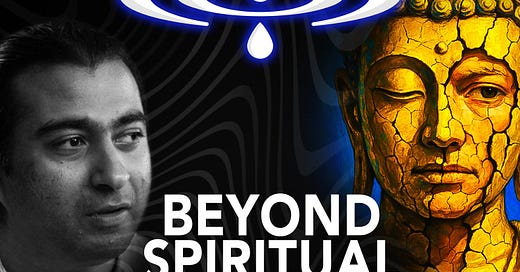🌀Awakening Beyond Spiritual Idealization
The pros and cons of being open about spiritual attainments, creating healthier dynamics with spiritual teachers, going beyond spiritual idealization & more.
It’s built into human nature to look to others for guidance, inspiration, and support. Teachers, mentors, and role models expand our sense of what’s possible—yet the same innocent impulse that initially points us in the right direction, like a GPS, can eventually steer us into dead ends or even off a cliff.
I’ve recently learned that this kind of overeliance can be a product of Idealization, a psychological defense mechanism that protects us from the messiness and imperfection of life, and nowhere is it more hazardous than on the spiritual path. Only in retrospect do I see how that idealizing impulse distorted my relationship with reality.
Throughout my journey, I’ve looked to various teachers as living proof that the seeds I plant in practice will one day bear fruit. In recent years, one practitioner I regarded as an exemplar was Delson Armstrong. I first heard Delson on the Guru Viking podcast, where he shared how, at the age of sixteen, he trekked to the Himalayas, meditating six to eight hours a day, studying sacred texts, and learning from masters across multiple lineages.
Through that intensive training, he developed the rare ability to enter nirodha-samāpatti—a state of total cessation of perception and feeling—for days at a time. The tale sounded mythical, something you might read out of the Autobiography of a Yogi, yet he came across as genuine and sincere. Later, neuroscience studies confirmed that he could indeed “shut down” his mind on demand.
Eager to learn more, I read Delson’s book A Mind Without Craving, started listening to his Dharma talks, and even planned to attend a retreat with him (although that didn’t work out). Over time, however, the teachings started to feel too by the book, a bit dry, and somehow out of reach. Delson wasn’t a monk, but he was teaching within a monastic context, and I began to wonder whether that frame would work for a family man such as myself.
Around that same period of doubt, I discovered a presentation titled “From Sutra to Tantra” by meditation practitioners Charlie Awbery and Jared Janes. In it, they made a distinction between a Sutric view, one grounded in renunciation, and a Tantric view, one that is life-affirming. Learning this distinction clarified my concern: At the time, Delson’s guidance was firmly Sutric, and I realized I needed something different, so I stepped back from his content for a while.
Soon after, I stumbled upon a five-hour critique of Delson and the TWIM community he was teaching in. It was meticulous and raised some fair questions, but as I continued to watch, it felt more like a takedown than an honest inquiry; something about it didn’t sit right.
Not long afterward, Delson released a video publicly renouncing some of his earlier attainments. The move struck me as bold and disarmingly human, challenging the pressure we place on spiritual teachers to appear flawless. In a later interview, he admitted feeling pushed to embody “the avatar of an arahant”—a fully enlightened being in the Theravāda tradition—and acknowledged that his early presentations may have fueled unrealistic expectations.
I appreciate him taking accountability, and I believe we must also acknowledge how our own innate drive to idealize, particularly in spirituality, also contributes to this unhealthy dynamic. Perhaps on some level, we can't help but idealize; nonetheless, we can stay alert to when this orientation steers us off course from our true path.
Delson’s journey is full of valuable lessons, both in genuine meditative insights and the honest struggle of an imperfect human, so I was delighted when he agreed to come on the podcast and share his unique perspective.
Click the video below and listen to our conversation where we explore Delson’s experience working with and integrating different traditions and spiritual practices, how coming across integral theory has helped him recontextualize the spiritual path, whether it’s possible to end suffering, the relationship between psychedelics & meditation, the pros and cons of being open about spiritual attainments, creating healtheir dynamics with spiritual teachers and going beyond spiritual idealization.
Insightful takeaways 🤓✍️
When a lineage markets itself as the lone highway to awakening, it is usually defending inherited cultural identity more than demonstrating unique effectiveness.
Buddhist (no-self) and Vedantic (true self) describe the same reality from different angles.
Awakening shortens the gap between disturbance and release; pain still arises, but recognition and letting go happen much faster.
Suffering is better translated as “a bummer”: like a shopping cart with one wheel slightly off, life is always a bit out of balance, and the task is steering, not fixing the cart forever.
Even the Buddha got annoyed; clinging to a flawless image of awakening only fuels more suffering.
Psychedelics can give useful glimpses or aid trauma release, but they’re not necessary for awakening. They can also become another attachment.
A working theory: ancient seekers may have turned to formal meditation only after the supply of psychoactive “soma” ran out, seeking a repeatable route to the same insight.
Publicly sharing attainments inspires some and provokes others; transparency is powerful but also paints a target, so timing and context matter.
Healthy teacher–student dynamics rest on clear boundaries and mutual questioning, preventing the swing from pedestal to witch-hunt.
You’re already liberated. You’ve just forgotten.
Dive Deeper 🤿
To never miss future episodes make sure to subscribe to the "Elevating Consciousness" podcast on Apple, Spotify, or on most other podcast apps, in which you can paste this RSS link.
You can also subscribe to the YouTube channel if you prefer to watch
Thanks for reading. If you enjoyed this read click the “subscribe now” button below to subscribe. If you're already a subscriber click the “share insighter” button to share with a friend or the “leave a comment” button to share some thoughts.




